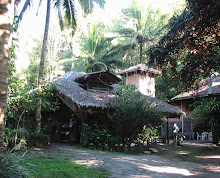Post-modern haute couture version of the traje de mestiza.
In no other former Spanish colony will you see any fashion that equals or surpasses the elegance, the refinement, the exquisite aesthetic of the "baro't saya" (English: dress and skirt), in Spanish called "el traje de mestiza". 19th century (or earlier) drawing of the garments and accessories that made up
the traditional traje de mestiza. Note the "Llavero" (key holder). In 19th century Western nations, ladies of the home (in English country houses, the head housekeeper) wore what was called the "chatelaine" (meaning "lady of the castle"), which was a chain around the waist from which hung the keys of the house.
The traje de mestiza is a wonderful creation that combines modesty and coquetry, and that showcased the art of fabric creation that was unique to Filipinas: wonderful, lightweight, transparent fabrics made from the fibers of the pineapple and the abaca plants. Called "piña" and "juse", they were used for the butterfly-sleeved blouse, and the stiff "pañuelo" or fichu worn over the shoulders over the décolletage. So the neck, shoulders and chest were covered but, at the same time, demurely seen through the transparency. The arms were visible through the transparent sleeves.
The "camisa" or blouse and the sleeves were richly decorated with embroidery and lace.
The skirts were also layered, either with petticoats as underskirts, or if the top skirt was translucent silk or taffetan, an overskirt was worn over it, draped or snugly wrapped down to the knees.
The traje de mestiza was perfect for the hot, humid climate.
Women had no need of corsets. Comfort and gracefulness, the beautiful colors and rich ornamentation and craftsmanship, the floating, rustling lightness of the woman's movements created the nimbus of gorgeous femininity, languorous Oriental seduction, but at the same time projecting decorousness and innocence.
Irresistible.
Filipina women had / have and were / are known for their beautiful skin, hands and feet, their natural grace.
Mestizas --- half-castes, mixed-bloods, were famous for their beauty and charm.
More images of the traje de mestiza, past and present (note how some of them look very camp, they are huge and floating on the lady):
Post-modern Filipina model wearing a classical-style traje de mestiza with tapis or overskirt.
This seems to be a painting that represents a 19th century Filipina
with a background of letters of the
ancient Tagalog alphabet.
Authentic 19th-century photograph. A Chinese mestiza Hispanic-Filipina.
Traditionally-styled traje de mestiza, postmodern era.
American Period, circa 1901. Sleeves became shorter and more skin started to show.
Sitters were less stiff, formal, serious; more alluring, accessible.
A young Spanish girl at a writing desk, either creole (born in Filipinas of Spanish parents)
or peninsular (born in Spain, living in Filipinas). 19th century. Interesting photograph because
it shows a girl at a desk, as though studying.
21st Filipina modelling a traditional, couture traje de mestiza.
Background seems to be Fort Santiago / el fuerte de Santiago.
Nota bene: Santiago Apostol, or the Apostle St. James,
is the patrón saint of Galicia and Spain.
Hispanic-Filipino family, possibly two married couples,
the men could be brothers.
Photograph taken around 1900 - 1910. In the first years of the American period,
Hispanic-Filipino gentlemen and ladies were very European in bearing and demeanor.
This photograph is a visual statement of Hispanic-Filipino urbanidad.
DEFINITION:
nombre femenino
Cortesanía, comedimiento, atención y buen modo.
Courtesy, restraint, attentiveness and good manners.
. . .
La cortesanía, los buenos modales, la educación y la urbanidad sugieren principalmente la observancia de maneras correctas en el trato social. La cortesía, la amabilidad y la afabilidad pueden comprender también la disposición o actitud interna que adoptamos ante los demás; sentimos la cortesía como más afectuosa, y por esto nos halaga más ser tratados con cortesía que con simple urbanidad.
Courtliness, good manners, politeness, and civility mainly suggest the observance of good manners in social interaction. Courtesy, amiableness, and affability can also encompass the inner disposition or attitude that we adopt in front of others; we feel courtesy as implying more affection. For this reason it is a greater compliment when we are treated with courtesy, more than with simple civility.
Urbanidad was a high value of Hispanic Filipino culture. It brought together the courtliness of ancestral Tagalog culture and that of medieval Muslim Spain. It was not a characteristic of Anglo-Saxon American culture, which was, at the time of the neocolonization of Filipinas, the new United States of the industrialized East and the Midwest and Far West that recently been won through the Indian Wars and the war with Mexico that stripped this republic of nearly two-thirds of its territory.
You don't champion urbanidad if you are bent on becoming an imperial power.
Despite the exaggerated glorification of pre-Hispanic indigenism, the cult to courtesy, gallantry and beautiful manners so characteristic of old Tagalog culture has been largely lost among the 21st century city-denizen Filipinos.



.jpg)
.jpg)
.jpg)
.jpg)
.jpg)
.jpg)




.jpeg)
